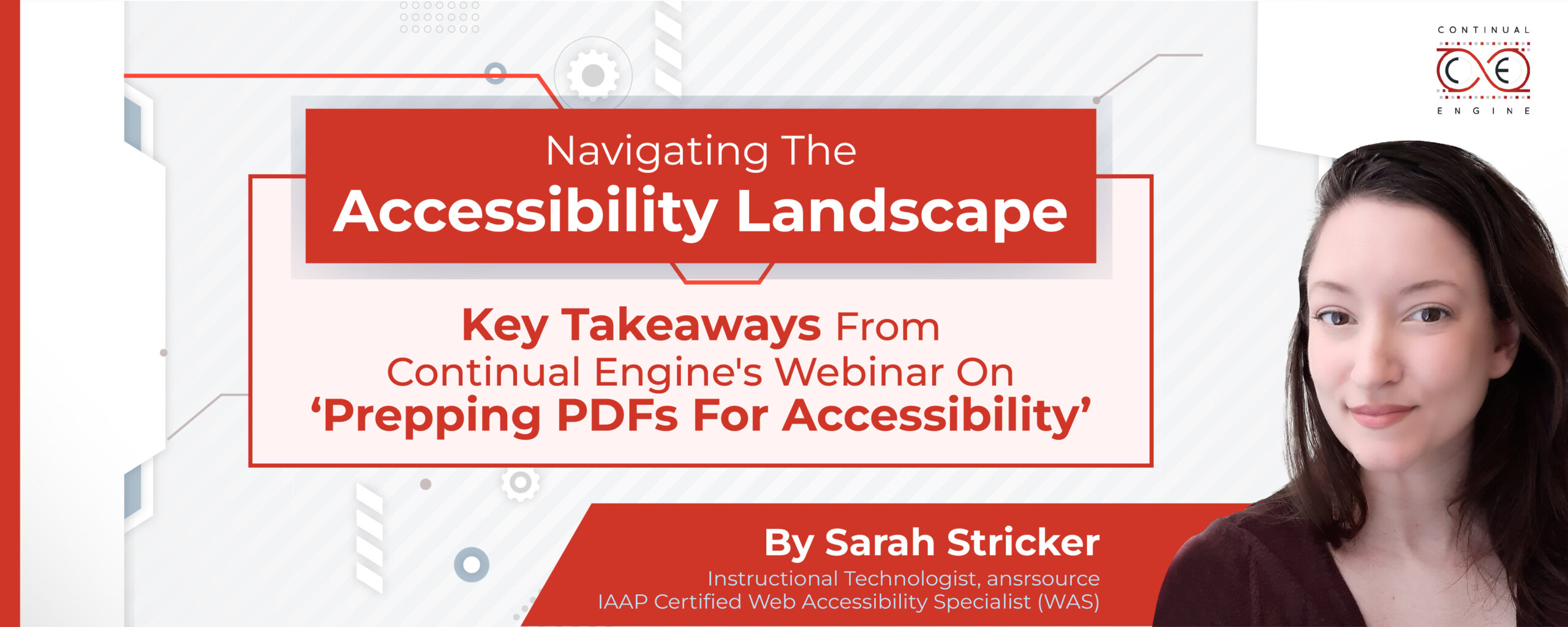In a digital-first world, PDFs have become a popular medium for sharing information. Owing to its rapid adoption, it is vital to ensure that PDFs are accessible to everyone, especially those using accessibility tools such as screen readers. To address this pertinent topic, Continual Engine recently hosted a webinar titled “Prepping PDFs For Accessibility”. With co-speaker Sarah Stricker, an Instructional Technologist and certified International Association of Accessibility Professionals (IAAP) Web Accessibility Specialist (WAS), the webinar’s primary objective was to offer valuable insights on creating visually appealing and user-friendly PDFs.
The webinar emphasized the importance of preparing documents for PDF accessibility by employing clear design principles, incorporating proper labels and text alternatives, and utilizing automated testing tools available in content authoring platforms. By following these practices, participants could gain practical knowledge to enhance the accessibility of their PDF documents, thereby ensuring an inclusive experience for all users.
This article aims to summarize the webinar’s key takeaways, invaluable insights, and best practices to help you create a more inclusive experience through the development of accessible PDFs. Let’s get started!
6 Key Takeaways On Accessible PDFs
Accessibility Requires Continuous Efforts And Improvements
PDFs Pose A Significant Accessibility Challenge For Users
Accessible PDFs Create A More Inclusive Learning Environment
Automation Enhances Efficiency And Remediation Turnaround Time
Manual remediation of PDFs can be time-consuming and resource-intensive. By leveraging automation tools such as PREP (PDF & Document Remediation Platform), institutions can streamline the process and efficiently remediate large volumes of PDFs with speed and accuracy.
Collaboration Helps Develop Better Accessibility Practices
Continuous Learning And Training Ensures Better Outcomes
What To Keep In Mind When Creating An Accessible PDF?
Understanding The Challenges Of PDF Accessibility
The Significance Of Accessibility In PDFs
Emphasizing Clear And Simplified Design
Considerations For Formatting And Text
Preparing Your Document
Final Thoughts
In conclusion, creating accessible PDFs is pivotal in ensuring accessible outcomes for all. By leveraging the key takeaways from Continual Engine’s webinar, “Prepping PDFs For Accessibility”, featuring Sarah Stricker, you can create and curate visually appealing and user-friendly PDFs. Through clear design, proper labeling, text alternatives, and automated testing tools, such as Continual Engine’s PREP (PDF & Document Remediation Platform), you can enhance the accessibility of their PDF documents.
When it comes to creating accessible PDFs, several considerations come into play. Understanding the challenges specific to PDF accessibility is essential, as is adhering to accessibility standards such as PDF/UA and WCAG. Emphasizing clear and simplified design principles, taking formatting and text into account, and utilizing content authoring tools, including PREP, to prepare documents are vital steps in ensuring accessibility.
The key takeaways from the webinar underscored the ongoing nature of accessibility efforts, the challenges posed by PDFs, the transformative impact of accessible PDFs on learning environments, the efficiency of automation tools like PREP, the collaborative efforts required for accessibility advancements, and the importance of continuous learning to stay abreast of evolving accessibility standards. By implementing the key strategies mentioned in this article and leveraging automation, inclusivity and an optimal user experience can be elevated to enable conducive learning environments for all individuals.

